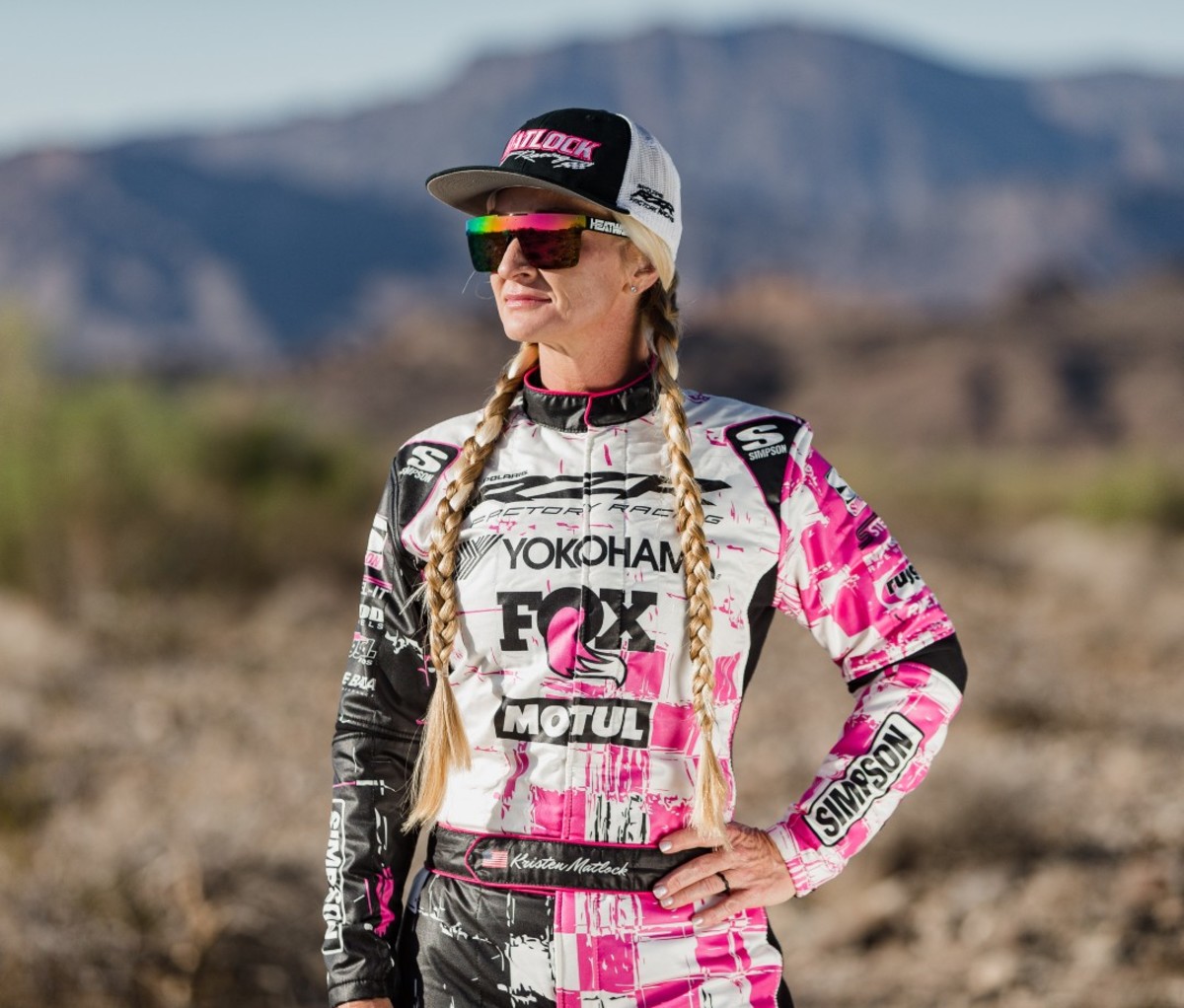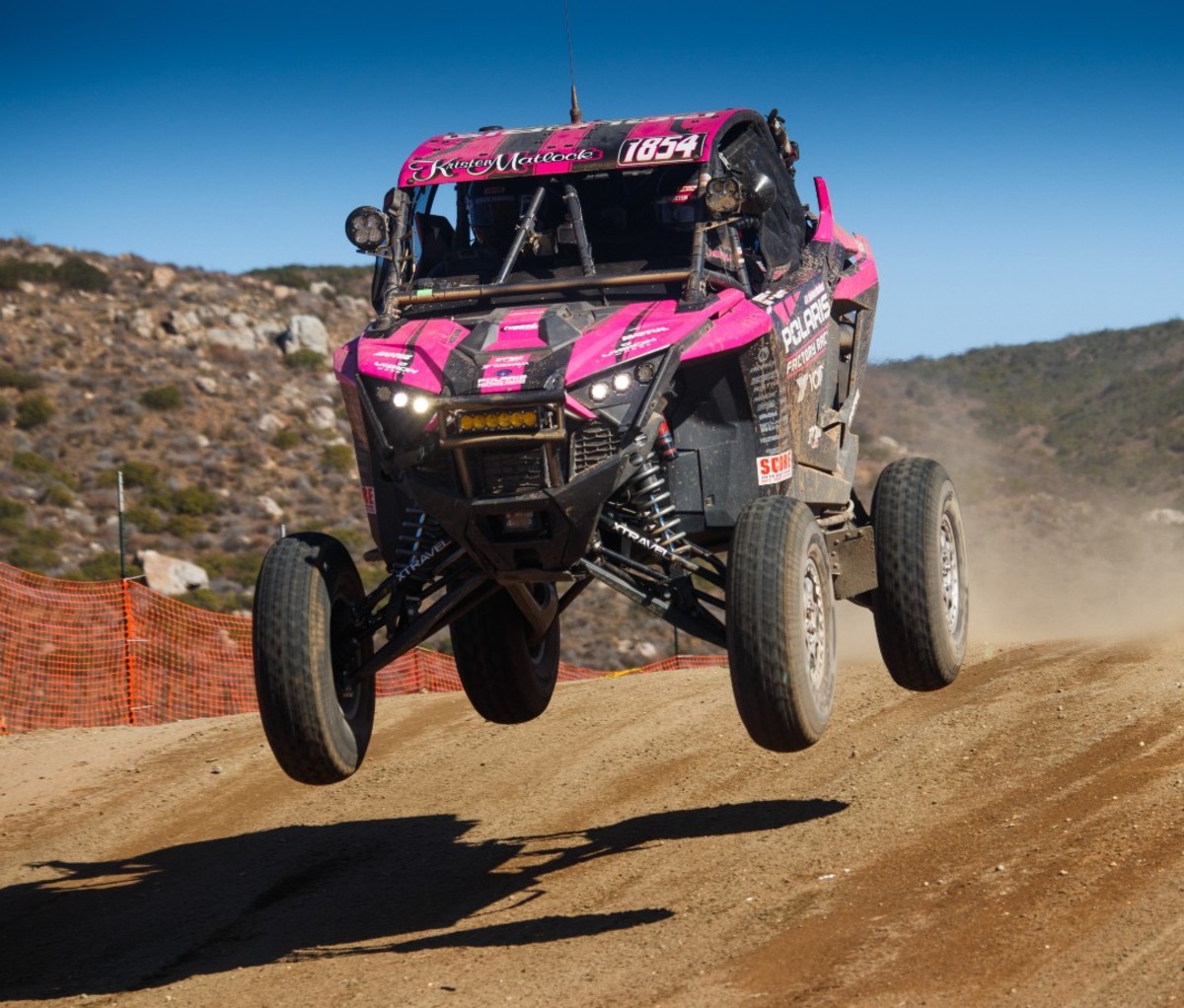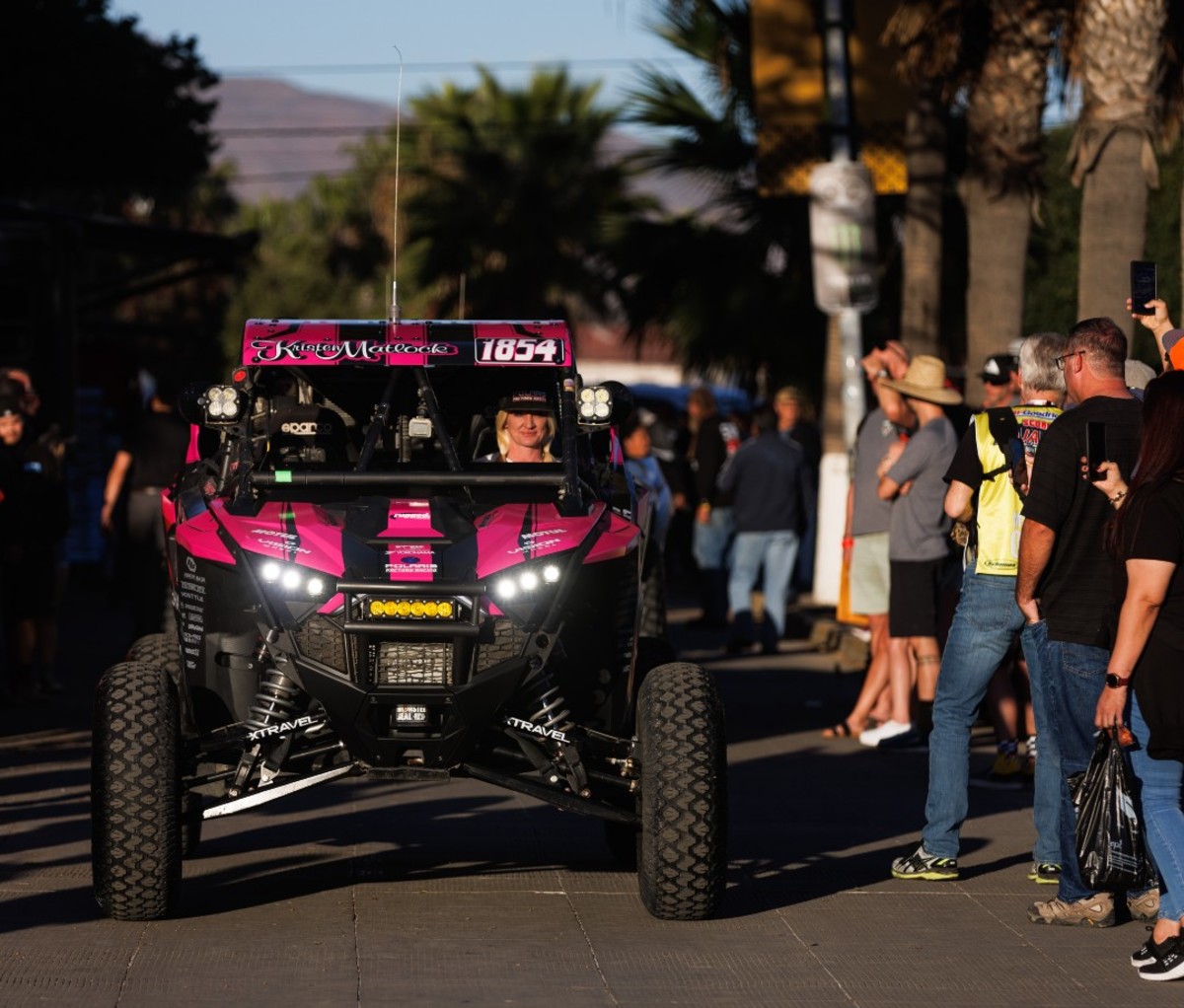[ad_1]
Kristen Matlock sits across from me in the living room of her Ensenada hotel room. Although we’re just 12 short hours from the kickoff of the Baja 1000, the scene is deceptively calm. Kristen is cheerful and relaxed, and if it weren’t for the piles of racing equipment and team uniforms littering the floor, you’d swear I’d caught her in the middle of a family vacation.
At 42 years old, Kristen is the poster child for a life well lived. She’s in absolute fighting shape, the result of a rigorous daily workout routine and an uncompromising training schedule. The smile on her face is as radiant as it is constant. If I hadn’t already seen what she can do behind the wheel of her Polaris RZR Pro R, I’d never guess I was talking to one of the most formidable figures in the off-road racing scene.
Kristen’s accomplishment is a staggering one to say the least. In just six short years, she has gone from owning her first UTV to being one of the most successful and recognizable figures in the sport. To date, her list of accolades includes a first place overall finish at the 2018 Baja 500, a first in class win at the San Felipe 250, and a first in class win at the 2019 Baja 1000. And, as icing on the cake, she’s driven every single mile of it without once sharing her seat. Nowadays, Kristen has a well deserved reputation as the “Ironwoman” of off-road racing, but things haven’t always been this way.

Ironwoman: Origin Story
Growing up, Kristen was one of those people who did well at pretty much everything. When she was younger, she was a gymnast for a while and then a figure skater. She was even a Girl Scout at one point, if you can believe it. She studied musical performance for a time as well (her father was a local musician who opened for acts like George Straight and Randy Travis). Ultimately, she ended up going to college to become a registered nurse.
It wasn’t until her college years that Kristen got her first taste of what would become a life-long career and passion. She was in desperate need of a break from her studies, so when some friends invited her out on an off-road trip to the desert, Kristen jumped at the opportunity. She didn’t own an off-road vehicle at the time, but a friend offered to let her ride a sister’s Yamaha Blaster for the weekend and Kristen decided to give it a shot.
“I remember all the boys were out there on the big two-stoke Yamaha Banshees. I was determined to keep up with them on that little 200cc quad. They were running around and jumping dunes and I was doing everything I could not to lose them. I remember I followed someone off a huge jump and the impact from the landing snapped my wrist.”
The crash left Kristen in a cast, unable to ride again for some time. But when her friends invited her back out the following weekend, she decided to go along anyway.
“I was stuck hanging around camp with a broken wrist, and that’s when I met Wayne,” she recalls. “He saw this little blonde girl sitting around in camp and decided to stay back and meet her while everyone else went out. That’s when it all started.”
That was Wayne Matlock—who is now Kristen’s husband and the second half of the double threat that is Matlock Racing. But this was back in 2001, when Wayne was just getting his start racing ATVs professionally.
The two hit it off, and before Kristen knew it, she was balancing a career as a registered nurse with a part time job as Wayne’s race manager. Nowadays, Matlock racing is a full-scale operation with factory support and five dedicated chase vehicles. Back then, it was just Wayne, Kristen, and a pickup truck.
“I’d drop him off, he’d go do a section, and then I’d pick him up at the end,” says Kristen. “It was a two-person show starting off, and it just progressed from there.”
Things really took off in Christmas of 2004 when Wayne surprised Kristen with her first ATV. Kristen was tired of watching her husband have all the fun from the cab of a chase truck, and shortly thereafter decided it was time to try getting out on the race course herself.
“We spent about six months training together,” she says. “I didn’t want to be that girl that everyone dreads taking out because she’s so slow. I pushed myself so hard to keep up with him and before I knew it I had gotten to the point that I was ready to enter a local race.”
Things moved quickly from there. Kristen had a rare talent for racing. She took home wins both in the womens class and overall competing against the men. Longer races proved to be particularly challenging though, and Kristen struggled to overcome the brutal physical demands of the sport.
“As a female racer, you’re just not as strong upper body-wise,” she says. “It takes a lot of strength to throw that quad around and just stay at it for hours and hours. When I finally made the transition to UTV’s, that factor went away and I really got a chance to shine.”
For Kristen that chance came in 2016, after over a decade of hard fought wins on the ATV circuit. She had never raced a four wheel drive vehicle in her life, yet alone something as capable as a Polaris RZR. Her husband Wayne had been racing UTVs for a little over a year at this point, so naturally she turned to him for training.
“I signed up for a local district UTV race, although I had no experiencing piloting a four wheel drive vehicle,” says Kristen. “It was a completely different feeling. We did a few hours of practice before the race, then I went out to compete that same morning.”
Despite having mere hours of practice under her belt, Kristen went out that morning and took home first place overall. Riding high on the thrill of her win, Kristen decided to jump straight into the UTV Championship race in Laughlin, NV, the following weekend. Against all odds, Kristen took an astonishing 2nd place finish in her first professional race. She finished in 3rd place overall of the 136 vehicles at the start line.
“From that day forward I had all the confidence I needed,” she says. “I realized right then that this was where I belonged. There was no looking back.”
The nursing job went out the window, and Kristen turned her laser focus to UTV racing. Some racers may have sneered at her hot pink car the first time they saw it on the starting grid, but by the end of the year, there was no denying Kristen Matlock was a force to reckon with.
She was winning major races left and right, nailing down both class titles and overall wins throughout the UTV category. This was impressive enough on its own, but what really brought her into the spotlight was the fact that she was winning all these races without the help of a codriver, choosing instead to “ironman” each race by driving every mile herself.
Fast forward to 2022: Kristen has now taken home titles in nearly every competition on the circuit. Her hard work and determination have undeniably paid off, but one title in particular has eluded her for the past six years: An overall win at the legendary Baja 1000. This year, Kristen came prepared to change that.

Race Day: The 2022 SCORE Baja 1000
It’s 6 a.m. the morning of the race and I wake up to a text from Kristen: The team meeting will start at 7a.m., and the cars will head to the starting line at 8:30. I’ve agreed to follow along in one of the Matlock Racing chase trucks for the entirety of the 828-mile loop from Ensenda to San Felipe and back, which means I don’t expect to see a bed or a shower for the next 20 hours or so.
The team gathers in Kristen’s room and goes over the final details of the race plan for the day. There are five trucks in total between Kristen and Wayne, and they’ve all got very specific schedules to keep for everything to go as planned. If all goes smoothly, Kristen hopes to cross the finish line just after 5 a.m. the following day. But, as I’ll soon come to learn, things rarely go smoothly out in the desert. Here’s how it all went down.
Pit 1: Mile 158
Kristen takes off from the starting line on schedule at 11:13 a.m. At this point, the chase crew and I have already been on the road for two hours. We’re headed to our first pit just outside of La Ventana. Kristen is expected to arrive there around 2:45 p.m. for a quick refuel.
We get news over the radio that a trophy truck has broken down on a narrow canyon pass. It’s creating a nasty bottleneck in the race course that stops all of the UTVs in their tracks. This means any gains or losses from the first three hours of racing will be lost. It also means that Kristen will be behind the wheel for an extra 45 minutes longer than originally planned.
Kristen pulls into the pit needing fuel and a tire replacement. I’m on “driver duty” for the race, so I hand Kristen and her navigator two bottles of water and a bag of cold chicken fingers through the driver side door. She chugs the water and eats as much of the chicken as she can in the two-minute window she’s allotted. But when the repairs are done it’s time to get back on the course. Kristen tosses her unfinished meal out the window and speeds off in a cloud of dust.
Pit 2: Mile 308
Kristen reports suspension issues over the radio, which she says are killing her speed over the whooped out sections of the course. The team scrambles to prepare the tools they’ll need for a suspension adjustment on the fly, as well as spare tires in case of a flat.
She finally makes it into the pit around 7:30 p.m. She’s now running an hour and a half behind schedule due to the rough ride and the earlier bottleneck. The team rushes in as Kristen slides to a stop in front of the pit, and immediately begins lifting the vehicle and wrenching on the front shocks. I pass cold peanut butter sandwiches and more waters in through the window.
The crew is unable to fit an impact gun up into the wheel well, so they use hand tools—and repairs take considerably longer than expected. A quick stop turns into a painful 15-minute ordeal, and Kristen grows more anxious with each passing second. She has now been behind the wheel for five and half hours straight.
Pit 3: Mile 450
We arrive at our third pit just before 10 p.m. Temperatures have fallen sharply since the sun went down, and it’s now around 40 degrees in the open desert. Kristen calls over the radio to report that her suspension is still struggling. The car is now jumping side to side at speed, limiting her pace over the unforgiving terrain.
Her car pulls into the pit at 11:25 p.m, now running over an hour behind the lead racer and the overall win Kristen is gunning for. The crew lifts the rear of the vehicle to try and sort out the suspension issues once again. As I approach the driver’s side window with more water and snacks, it’s clear Kristen has been fighting tears and the rough ride is taking a toll on her body.
This time she asks me for two high-strength Excedrin and two antacid pills to boot. There are still seven pitch black hours of racing ahead and temperatures will only drop from here. I hand Kristen a jacket to wear for the rest of the night. The team does what they can to soften the suspension while Kristen eats more sandwiches through her helmet’s visor. It’s another long pit for the 1854 car, and by the time repairs are finished and Kristen tears back onto the race course, she’s been behind the wheel for nearly 13 hours straight.
Pit 4: Mile 681
Exhausted from a full day on the road, I somehow manage to fall asleep in the back seat of the truck for an hour or so of much needed rest. When I awake, it’s just after 1 a.m. and we’re across from a taco stand. Much to my surprise, the stand is still open and serving a hungry crowd of race fans.
The wait is a long one, but around 4 a.m. Kristen comes back over the radio with bad news. The lug nuts on one of her wheels have come loose, causing a hub failure on vehicle’s rear end. They don’t have the parts or the tools on the race car to make the repairs themselves. They’re stuck sitting on the side of the course for over an hour waiting on a prerunner to get them back up and running.
Temperatures in the desert have now dropped down below freezing. Kristen will be sitting in the dark with nothing but a light jacket to keep her warm until help arrives. She’s now been driving for 17 hours straight, and awake for over 22 hours total.
Once repairs are finally made, Kristen makes her way into our makeshift pit lane. The sun has been up for over an hour. She knows beyond a doubt that the win has eluded her once again this year—but I also notice her spirits are the highest they’ve been since she left the morning before. She chokes down another sandwich and chugs another bottle of water. Kristen gets back on the road with a smile and a wave. 147 miles left to go.
Finish Line: Mile 828.25
Our pit crew makes two more stops along the way, just in case Kristen needs another repair. However, the rest of the race goes on without so much as a flat tire. Kristen blazes past both pits at full speed each time, giving a cheerful blip of her siren as she passes.
The next time I see her, Kristen is at the finish line, smiling just as brilliantly as ever. She’s giving an interview for the TV cameras, but there’s no question she’s ready to drop. Somehow, she musters the strength to take pictures with every fan flagging her down on the way to the exit.
After 24 hours and 50 minutes of what Kristen will come to refer to as the most challenging race of her career, she’s in no hurry to get back to her bed for some desperately needed sleep. As her car is swarmed by a group of young women who’ve been waiting faithfully to watch their hero cross the finish line, there’s no doubt in my mind what keeps Kristen going when things are at their darkest.
That’s a real professional for you. That’s the Ironwoman.

Epilogue:
Kristen lays in bed upstairs in her Ensenada hotel room with an IV full of fluids in her arm. She’s running a fever and her harrowing ordeal has left her with a nasty upper respiratory infection. She’s in no condition to talk, so over the next few days we catch up over the phone.
“That breakdown was one of the toughest moments I’ve ever been through,” she says. “Once we stopped moving, my body stopped working and I got cold fast. Temperatures were down in the low 20s and I couldn’t even get out to stretch my legs because I had to keep warm.”
With no chance of winning and being just two miles from the nearest pit, Kristen had a a choice. Forfeit the race and try again next year, or sit through the blistering cold for a chance to finish her 7th solo run of the Baja 1000.
“I’ve never quit a single race,” she says. “Some are extremely challenging and I’m sure many of the racers out there would probably call it quits—but I just don’t have it in me. Sometimes the car is damaged beyond repair, but for me to call it because I feel physically unable? That just isn’t gonna happen.”
After the race, the Matlock team wastes no time getting back to the drawing board. Kristen is building a new car for the 2023 season. This year’s Baja was a hard lesson on what they’ll need next year.
“We realized that because we’re carrying 39 gallons of fuel in the rear of the car, handling is completely different when its full than it is when we’re running low,” she says. “Next season we’re moving the fuel cell to the middle of the car to even it out. We’re also moving up to a 35” Yokohama tire to lower stress on the suspension. We’re still learning after all this time, but I think we got everything we needed to make it happen next year.”
While desert racing will always be unpredictable, one thing is for certain: The Ironwoman will be back next year. If you see her bright pink car in your mirrors, you’d do well to get the hell out of her way.
For access to exclusive gear videos, celebrity interviews, and more, subscribe on YouTube!
[ad_2]